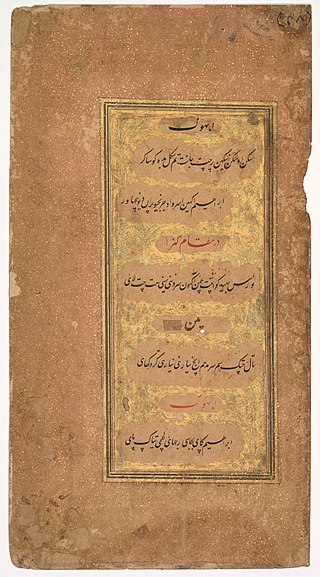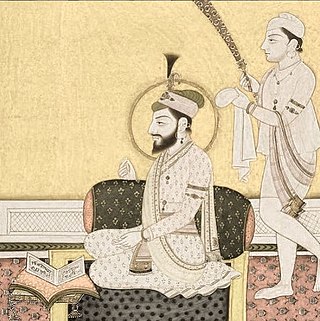Examples of borrowed words
Due to centuries of contact with Europeans, Turkic peoples, Arabs, Persians, and East Asians, Hindi-Urdu has absorbed countless words from foreign languages, often totally integrating these borrowings into the core vocabulary. The most common borrowings from foreign languages come from three different kinds of contact. Close contact with neighboring peoples facilitated the borrowing of words from other Indian languages, Chinese, Burmese, and several indigenous Austroasiatic languages of North India. After centuries of invasions from Persia and the Middle East, particularly under the Mughal Empire, numerous Turkish, Arabic, and Persian words were absorbed and fully integrated into the lexicon. Later, European colonialism brought words from Portuguese, French, Dutch, and most significantly English. Some very common borrowings are shown below.
Borrowings from neighboring languages
Austroasiatic languages (देशज دیشج Deshaj)
| Word | Meaning |
|---|---|
| आलू آلو ālū | potato |
| खोज کھوج khoj | discovery |
| चावल چاول cāwal | rice grains |
| चूल्हा چولہا cūlhā | oven, stove |
| झोल جھول jhol | gravy |
| टांग ٹانگ ṭaṅg | leg |
| ढोल ڈھول ḍhol | dhol, drum |
| पेट پیٹ peṭ | belly |
Chinese (चीनी چینی Chīnī)
| Word | Meaning | Original form |
|---|---|---|
| चाय چائے cāy | tea | 茶 chá |
| चीनी چینی cīnī | sugar | |
| लीची لیچی līcī | lychee | 茘枝 lìzhī |
Borrowings from the Persianate era
Arabic (अरबी عربی Arabī)
| Word | Meaning | Original form |
|---|---|---|
| अक़्ल عقل aqal | wisdom | عقل ‘aql |
| इलाक़ा علاقہ ilāqā | area | علاقة `alāqa "relationship, connection" |
| वज़न وزن vazan | weight | وزن wazn "scale" |
| क़बर قبر qabr | grave | قبر qubr |
| ख़बर خبر k͟habar | news | خبر khabar |
| ख़ाली خالی k͟hālī | empty | خالي khālī |
| ख़्याल خیال k͟hayāl | consideration | خيال khayal " imagination" |
| ग़रीब غریب ġarīb | poor | غريب gharīb "strange" |
| जवाब جواب javāb | answer | جواب jawāb |
| सवाल سوال sovāl | question | سؤال so'āl |
| जमा جمع jamā | collect | جمع jam‘ |
| तारीख़ تاریخ tārīk͟h | date | تاريخ tārīkh "history, date" |
| दुनिया دنیا duniyā | world | دنيا dunya |
| नक़ल نقل naqal | fake | نقل naql |
| फ़क़ीर فقیر faqīr | poor person | فقير faqīr |
| बदल بدل badal | exchange | بدل badl |
| बाक़ी باقی bāqī | remaining | بقي baqīy |
| साहब صاحب sāhab | sir | صاحب ṣāḥib "friend" |
| हिसाब حساب hisāb | calculation | حساب ḥisāb |
| मालिक مالک mālik | owner | مالك mālik "owner, proprietor, holder" |
| लज़ीज़ لذیذ lazeez | delicious | لذيذ latheeth "tasty" |
| किताब کتاب "kitāb" | book | كتاب kitab "book" |
| एहतियात احتیاط "ehtiyāt" | precaution | احتياط aihtiat "precaution,reserve" |
| शख़्स شخص "shakhs" | person | شخص shakhs "person" |
| शहीद شہید "shaheed" | martyr | شهيد shahid "martyr" |
| हद حد "had" | limit | حد hada "limit" |
| सेहत صحت "sehat" | health | صحة siha "health" |
Persian (फ़ारसी فارسی)
| Word | Meaning | Original Form |
|---|---|---|
| ख़ुश خوش khush | happy | خوشحال khushal |
| दर्द درد dard | pain | درد dərd |
| बदन بدن badan | body | بدن bədən |
| शायद شاید shayad | maybe | شاید shayad |
| हमेशा ہمیشہ hamesha | always | همیشه həmesha |
| साल سال saal | year | سال sāl |
| गरम گرم garam | warm | گرم gərm |
| आसमान آسمان aasman | sky | آسمان aasman |
| ज़मीं زمین zameen | land | زمین zəmeen "the earth" |
| रोज़ा روزہ roza | fasting | روزه roza "a fast" |
Turkish (तुर्की ترکی Turkī)
| Word | Meaning | Original form |
|---|---|---|
| उर्दू اردو Urdu | Urdu | ordu "army" |
| क़ैंची قینچی qãincī | scissors | |
| क़ोरमा قورمہ qormā | korma | kavurma in Turkish |
| बावर्ची باورچی bāwarchī | cook, chef | Ashchi (soupmaker) in modern Turkish |
| बेगम بیگم begam | lady | begüm |
| लाश لاش lāś | corpse | (Turkish pron. = lesh) |
| क़ुली قلی qulī | laborer, porter | porter, servant |
| घूर گھور ghūr | a stare, staring | göz (eye) in Turkish |
Borrowings from the Colonial Era
Portuguese (पुर्तगाली پرتگالی Purtugālī)
Portuguese borrowings mostly describe household items, fruits, and religious concepts dealing with Catholicism:
Household
| Word | Meaning | Original form |
|---|---|---|
| अलमारी الماری almāri | closet, cupboard | armário |
| इस्तरी استریistrī | to iron | estirar (means to lengthen a cable) |
| इस्पात ایسپات ispāt | steel | espada "sword" |
| गमला گملا gamlā | basket | gamela "wooden trough" |
| चाबी چابی cābī | key | chave |
| जंगला جنگلا jaṅglā | window-railing | janela |
| तम्बाकू تمباکو tambākū | tobacco | tobacco |
| तौलिया تولیہ tauliyā | towel | toalha |
| फ़ीता فیتا fītā | lace, ribbon | fita |
| बराम्दा برآمدہ baramdā | verandah | varanda |
| बाल्टी بالٹی bāltī | pail | balde |
| साबुन صابن sābun | soap | sabão |
Food
| Word | Meaning | Original form |
|---|---|---|
| अनानास انناس anānās | pineapple | ananás |
| काजू کاجو kāju | cashew | caju |
| गोभी گوبھیgobhī | cabbage, cauliflower | couve |
| पाउ रोटी پاو روٹی pāu roṭī | sliced bread | pão "bread" (generic name for bread) |
| पपीता پپیتا papītā | papaya | papaia |
| साबूदाना سابودانا sābūdānā | sago | sagu |
| सलाद سلاد salād | salad | salada |
Religion
| Word | Meaning | Original form |
|---|---|---|
| क्रूस کروس krūs | cross | cruz |
| गिरजा گرجا girjā | church | igreja |
| पादरी پادری padrī | Christian priest/minister | padre |
Other
| Word | Meaning | Original form |
|---|---|---|
| अंग्रेज़ انگریز aṅgrez | English | inglês |
French (फ़्रान्सीसी فرانسیسی Fransisi)
Only a handful of French borrowings are still used in Hindi today.
| Word | Meaning | Original form |
|---|---|---|
| कारतूस کارتوس kārtūs | cartridge | cartouche |
| रेस्तराँ ریستوراں restarā̃ | restaurant | restaurant |
English (अंग्रेज़ी انگریزی Aṅgrezī)
Most borrowed words of European origin in Hindi-Urdu were imported through English and involve civic and household concepts:
Civic Life
| Word | Original form |
|---|---|
| अफ़सर افسر afsar | officer |
| जेल جیل jel | jail |
| डॉक्टर ڈاکٹر ḍôktar | doctor |
| पुलिस پولیس pulis | police |
| बैंक بینک baiṅk | bank |
| वोट ووٹ voṭ | vote |
| स्कूल اسکول skūl/iskūl | school |
Household
| Word | Original form |
|---|---|
| कप کپ kap | cup |
| गिलास گلاس gilās | glass |
| टेबल ٹیبل ṭebal | table |
| बॉक्स بکس bôks | box |
| लालटेन لالٹین lālṭen | lantern |
| कनस्तर کنستر kanastar | canister |












